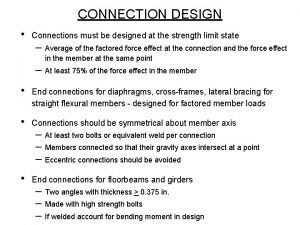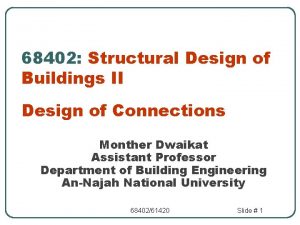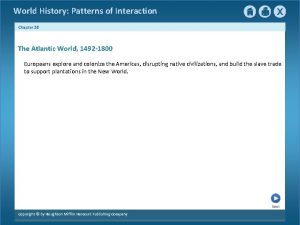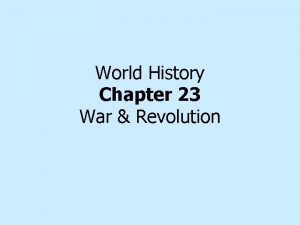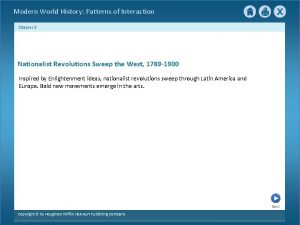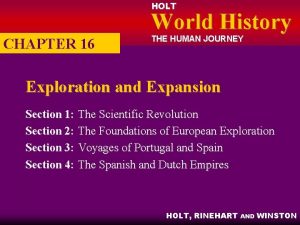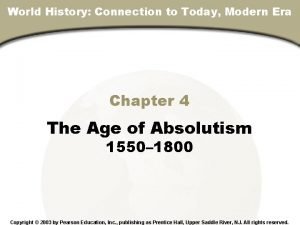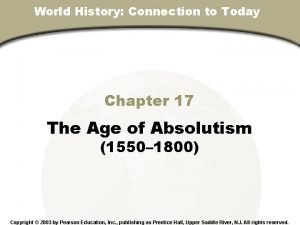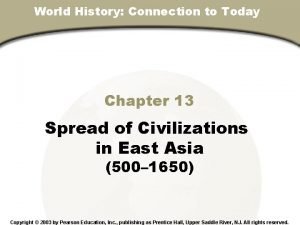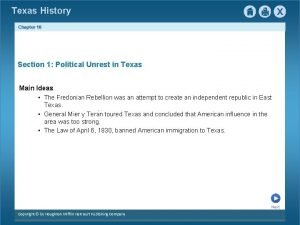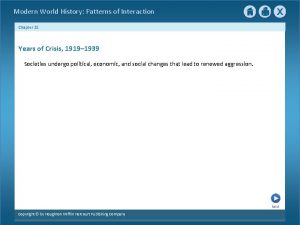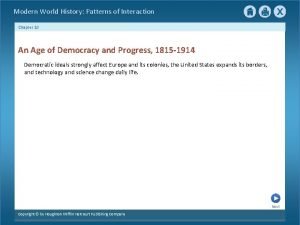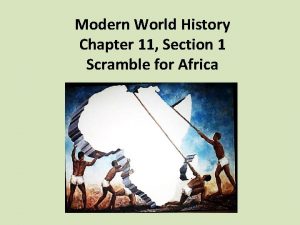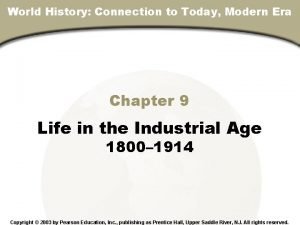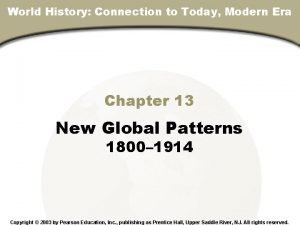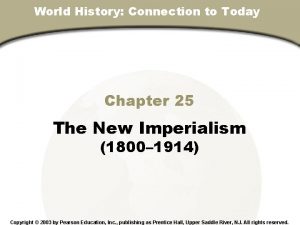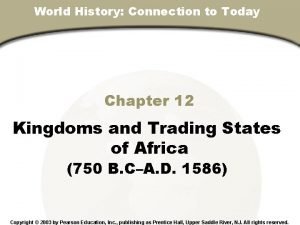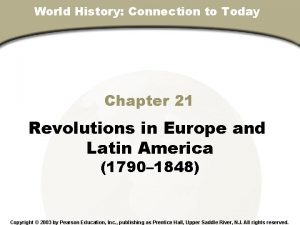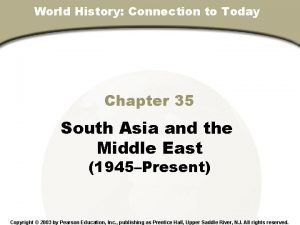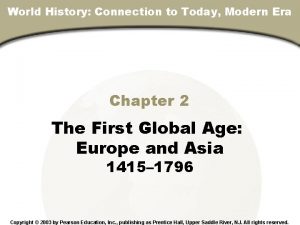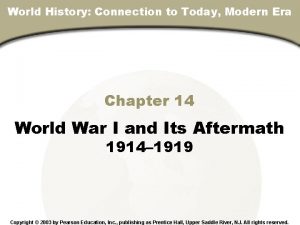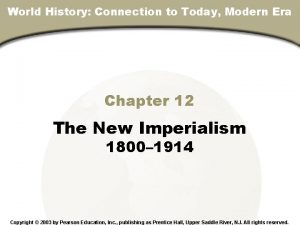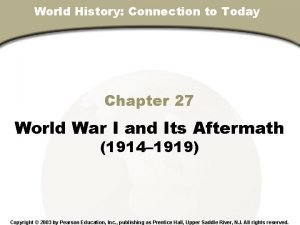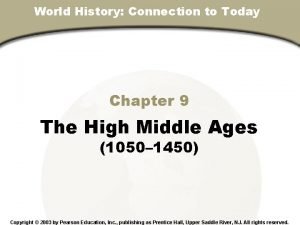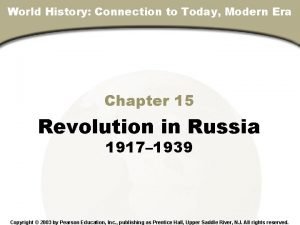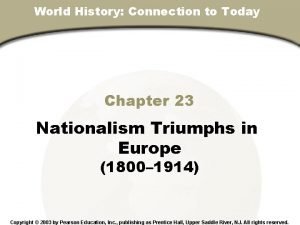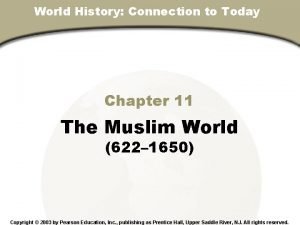Chapter 9 Section World History Connection to Today
































- Slides: 32

Chapter 9, Section World History: Connection to Today, Modern Era Chapter 9 Life in the Industrial Age 1800– 1914 Copyright © 2003 by Pearson Education, Inc. , publishing as Prentice Hall, Upper Saddle River, NJ. All rights reserved.

Chapter 9, Section World History: Connection to Today, Modern Era Chapter 9: Life in the Industrial Age 1800– 1914 Section 1: The Industrial Revolution Spreads Section 2: The World of Cities Section 3: Changing Attitudes and Values Section 4: A New Culture Copyright © 2003 by Pearson Education, Inc. , publishing as Prentice Hall, Upper Saddle River, NJ. All rights reserved.

Chapter 9, Section 1 The Industrial Revolution Spreads • What industrial powers emerged in the 1800 s? • What impact did new technology have on industry, transportation, and communication? • How did big business emerge in the late 1800 s?

Chapter 9, Section 1 New Industrial Powers During the early Industrial Revolution, Britain stood alone as the world’s industrial giant. By the mid-1800 s, other nations had joined the race, and several newcomers were challenging Britain’s industrial supremacy. • • • Belgium became the first European nation outside Britain to industrialize. Germany united into a powerful nation in 1871. Within a few decades, it became Europe’s leading industrial power. The United States made rapid technological advances, especially after the Civil War. By 1900, American industry led the world in production. Japan industrialized rapidly after 1868. Canada, New Zealand, and Australia built thriving industries. Eastern and southern Europe industrialized more slowly. These nations lacked natural resources or the capital to invest.

Chapter 9, Section 1 Centers of Industry

Chapter 9, Section 1 Technology and Industry The marriage of science, technology, and industry spurred economic growth. To improve efficiency, manufacturers designed products with interchangeable parts. They also introduced the assembly line. STEEL Henry Bessemer developed a process to produce stronger steel. Steel quickly became the major material used in tools, bridges, and railroads. CHEMICALS Chemists created hundreds of new products. New chemical fertilizers led to increased food production. Alfred Nobel invented dynamite. ELECTRICITY Alessandro Volta developed the first battery. Michael Faraday created the first electric motor and the first dynamo, a machine that generates electricity. Thomas Edison made the first electric light bulb.

Chapter 9, Section 1 Advances in Transportation and Communication During the second Industrial Revolution, transportation and communication were transformed by technology. TRANSPORTATION • Steamships replaced sailing ships. • Rail lines connected inland cities and seaports, mining regions and industrial centers. • Nikolaus Otto invented a gasoline-powered internal combustion engine. • Karl Benz patented the first automobile. • Henry Ford began mass producing cars. • Orville and Wilbur Wright designed and flew the first airplane. COMMUNICATION • Samuel Morse developed the telegraph. • Alexander Graham Bell patented the telephone. • Guglielmo Marconi invented the radio.

Chapter 9, Section 1 The Rise of Big Business New technologies required the investment of large amounts of money. To obtain capital, entrepreneurs sold stock, or shares in their companies, to investors. Large-scale companies formed corporations, businesses that are owned by many investors who buy shares of stock. Powerful business leaders created monopolies and trusts, huge corporate structures that controlled entire industries or areas of the economy. Sometimes a group of businesses joined forces and formed a cartel, an association to fix prices, set production quotas, or control markets.

Chapter 9, Section 1 Assessment Which of the following areas was the slowest to industrialize? a) the United States b) Japan c) Eastern Europe d) Australia What did Henry Bessemer invent? a) the light bulb b) the battery c) the combustion engine d) a process to produce stronger steel Want to connect to the World History link for this section? Click Here!

Chapter 9, Section 1 Assessment Which of the following areas was the slowest to industrialize? a) the United States b) Japan c) Eastern Europe d) Australia What did Henry Bessemer invent? a) the light bulb b) the battery c) the combustion engine d) a process to produce stronger steel Want to connect to the World History link for this section? Click Here!

Chapter 9, Section 2 The World of Cities • What was the impact of medical advances in the late 1800 s? • How had cities changed by 1900? • How did working-class struggles lead to improved conditions for workers?

Chapter 9, Section 2 Population Explosion Between 1800 and 1900, the population of Europe more than doubled. This rapid growth was not due to larger families. Instead, population soared because the death rate fell. The drop in the death rate can be attributed to the following: • People ate better. • Medical knowledge increased. • Public sanitation improved. • Hygiene improved. Year Male Female 1850 1870 1890 1910 42. 8 years 44. 7 years 48. 5 years 56. 0 years 40. 3 years 42. 3 years 45. 8 years 52. 7 years

Chapter 9, Section 2 Advances in Medicine Improved medicine and hygiene played a major role in increasing life expectancy in the industrialized world. LOUIS PASTEUR proved the link between microbes and disease, developed vaccines against rabies and anthrax, and discovered the process of pasteurization, the killing of disease-carrying microbes in milk. ROBERT KOCH identified the bacteria that caused tuberculosis. FLORENCE NIGHTINGALE insisted on better hygiene in wartime field hospitals, introduced sanitary measures in British hospitals, and founded the world’s first nursing school. JOSEPH LISTER discovered how antiseptic prevented infection.

Chapter 9, Section 2 City Life As industrialization progressed, cities came to dominate the West. At the same time, city life underwent dramatic changes. • Settlement patterns shifted: the rich lived in pleasant neighborhoods on the outskirts of the city, while the poor crowded into slums near the city center. • Paved streets, gas lamps, organized police forces, and expanded fire protection made cities safer and more livable. • Architects began building soaring skyscrapers made of steel. • Sewage systems improved public health.

Chapter 9, Section 2 Working-Class Struggles Workers protested to improve the harsh conditions of industrial life. At first, business owners tried to silence protesters, strikes and unions were illegal, and demonstrations were crushed. By mid-century, workers slowly began to make progress: • Workers formed mutual-aid societies, self-help groups to aid sick or injured workers. • Workers won the right to organize unions. • Governments passed laws to regulate working conditions. • Governments established old-age pensions and disability insurance. • The standard of living improved.

Chapter 9, Section 2 The Industrial Revolution: Cause and Effect • • • • Causes Increased agricultural productivity Growing population New sources of energy, such as steam and coal Growing demand for textiles and other massproduced goods Improved technology Available natural resources, labor, and money Strong, stable governments that promoted economic growth Immediate Effects Rise of factories Changes in transportation and communication Urbanization New methods of production Rise of urban working class Growth of reform movements • • Long-Term Effects Growth of labor unions Inexpensive new products Spread of industrialization Rise of big business Expansion of public education Expansion of middle class Competition for world trade among industrialized nations Progress in medical care

Chapter 9, Section 2 Assessment What was the life expectancy of a woman in 1910? a) 56 years b) 42. 8 years c) 52. 7 years d) 80 years Which was a cause of the Industrial Revolution? a) the rise of factories b) the growth of labor unions c) the rise of big business d) new sources of energy such as coal and steam Want to connect to the World History link for this section? Click Here!

Chapter 9, Section 2 Assessment What was the life expectancy of a woman in 1910? a) 56 years b) 42. 8 years c) 52. 7 years d) 80 years Which was a cause of the Industrial Revolution? a) the rise of factories b) the growth of labor unions c) the rise of big business d) new sources of energy such as coal and steam Want to connect to the World History link for this section? Click Here!

Chapter 9, Section 3 Changing Attitudes and Values • What values shaped the new social order? • How did women and educators seek change? • How did science challenge existing beliefs? • What role did religion play in urban society?

Chapter 9, Section 3 What Values Shaped the New Social Order? • A strict code of etiquette governed social behavior. • Children were supposed to be “seen but not heard. ” • Middle-class parents had a large say in choosing whom their children married. At the same time, the notion of “falling in love” was more accepted than ever before. • Men worked while women stayed at home. Books, magazines, and popular songs supported a cult of domesticity that idealized women and the home.

Chapter 9, Section 3 Rights for Women • Across Europe and the United States, politically active women campaigned for fairness in marriage, divorce, and property laws. • Women’s groups supported the temperance movement, a campaign to limit or ban the use of alcoholic beverages. • Before 1850, some women had become leaders in the union movement. • Some women campaigned to abolish slavery. • Many women broke the barriers that kept them out of universities and professions. • In the mid- to late 1800 s, groups dedicated to women’s suffrage emerged.

Chapter 9, Section 3 Growth in Public Education • By the late 1800 s, reformers persuaded many governments to set up public schools and require basic education for all children. • Governments began to expand secondary schools, or high schools. • Colleges and universities expanded during this period. Universities added courses in the sciences to their curriculums. • Some women sought greater educational opportunities. By the 1840 s, a few small colleges for women opened.

Chapter 9, Section 3 New Directions in Science In the late 1800 s, researchers advanced startling theories about the natural world. These new ideas challenged long-held beliefs. • • John Dalton developed modern atomic theory. He showed how different kinds of atoms combine to make all chemical substances. Dmitri Mendeleyev grouped the elements according to their atomic weights. Charles Lyell and his successors offered evidence that the Earth had formed over billions of years and that life had not appeared until long after the Earth was formed. These ideas conflicted with biblical accounts of creation. Charles Darwin put forward theory of natural selection. Darwin’s theory ignited a furious debate between scientists and theologians.

Chapter 9, Section 3 Religion in an Urban Age Despite the challenge of new ideas, religion continued to be a major force in western society. • Christian churches and Jewish synagogues remained at the center of communities. • Religious leaders influenced political, social, and educational developments. • Religious organizations provided social services to the poor. • The social gospel was a movement that urged Christians to social service.

Chapter 9, Section 3 Assessment In the 1800 s, all of the following changes took place in education in many nations, except: a) Governments set up public schools. b) Basic education became required for all children. c) Women were regularly admitted to all-male universities. d) Governments expanded secondary schools. Who developed modern atomic theory? a) John Dalton b) Charles Darwin c) Charles Lyell d) Dmitri Mendeleyev Want to connect to the World History link for this section? Click Here!

Chapter 9, Section 3 Assessment In the 1800 s, all of the following changes took place in education in many nations, except: a) Governments set up public schools. b) Basic education became required for all children. c) Women were regularly admitted to all-male universities. d) Governments expanded secondary schools. Who developed modern atomic theory? a) John Dalton b) Charles Darwin c) Charles Lyell d) Dmitri Mendeleyev Want to connect to the World History link for this section? Click Here!

Chapter 9, Section 4 A New Culture • What themes shaped romantic art, literature, and music? • How did realists respond to the industrialized, urban world? • How did the visual arts change?

Chapter 9, Section 4 Romanticism Romantic writers, artists, and composers rebelled against the Enlightenment emphasis on reason. They glorified nature and sought to excite strong emotions in their audiences. ART Painters broke free from the discipline and rules of the Enlightenment. J. M. W. Turner captured the beauty and power of nature. Eugène Delacroix painted dramatic action. LITERATURE Writers created a new kind of hero, a mysterious, melancholy figure out of step with reality. Lord Byron described the romantic hero in his poetry. Charlotte Brontë wove a mysterious tale in Jane Eyre. MUSIC Composers tried to stir deep emotions. Ludwig van Beethoven combined classical forms with a stirring range of sound. Frederic Chopin conveyed the sorrow of people living under foreign occupation.

Chapter 9, Section 4 Realism • By the mid-1800 s, a new artistic movement, realism, took hold in the West. Realism was an attempt to represent the world as it was. • Realists often focused their work on the harsh side of life in cities or villages. Many writers and artists were committed to improving the lot of the unfortunates whose lives they depicted. • The English novelist Charles Dickens vividly portrayed the lives of slum dwellers and factory workers. • The Norwegian dramatist Henrik Ibsen wrote plays that attacked the hypocrisy he observed around him. • The French painter Gustave Courbet focused on ordinary subjects.

Chapter 9, Section 4 The Visual Arts • By the 1840 s, a new art form, photography, was emerging. The first photos were stiff, posed portraits. In time, photographers used the camera to present the grim realities of life. • Photography posed a challenge to painters. Why try for realism, they asked, when a camera could do the same thing better? • By the 1870 s, a group of painters sought to capture the first fleeting impression made by a scene or an object on the viewer’s eye. This new movement was known as impressionism. • Later painters, called postimpressionists, developed a variety of styles.

Chapter 9, Section 4 Assessment Which of the following was a romantic writer? a) Charles Dickens b) Lord Byron c) Henrik Ibsen d) Eugène Delecroix What novelist portrayed the lives of slum dwellers and factory workers? a) Charlotte Brontë b) Lord Byron c) Charles Dickens d) Frederic Chopin Want to connect to the World History link for this section? Click Here!

Chapter 9, Section 4 Assessment Which of the following was a romantic writer? a) Charles Dickens b) Lord Byron c) Henrik Ibsen d) Eugène Delecroix What novelist portrayed the lives of slum dwellers and factory workers? a) Charlotte Brontë b) Lord Byron c) Charles Dickens d) Frederic Chopin Want to connect to the World History link for this section? Click Here!
 Slip critical connection vs bearing connection
Slip critical connection vs bearing connection A490n bolts
A490n bolts Slip critical
Slip critical Image into text
Image into text Ap world history chapter 25 africa and the atlantic world
Ap world history chapter 25 africa and the atlantic world Chapter 17 section 3 world history
Chapter 17 section 3 world history Chapter 30 section 2 world history
Chapter 30 section 2 world history Chapter 15 section 1 world history
Chapter 15 section 1 world history World history chapter 15 section 3
World history chapter 15 section 3 Chapter 20 section 4 world history
Chapter 20 section 4 world history Chapter 8 section 2 world history
Chapter 8 section 2 world history Chapter 23 section 3 world history
Chapter 23 section 3 world history Chapter 8 section 1 world history
Chapter 8 section 1 world history Chapter 16 section 1 world history
Chapter 16 section 1 world history Chapter 14 section 1 world history
Chapter 14 section 1 world history Chapter 4 section 4 world history
Chapter 4 section 4 world history Absolute monarchy in russia
Absolute monarchy in russia World history chapter 13 section 1
World history chapter 13 section 1 World history chapter 10 section 1
World history chapter 10 section 1 Chapter 15 section 1 postwar uncertainty
Chapter 15 section 1 postwar uncertainty Chapter 10 section 1 world history
Chapter 10 section 1 world history Chapter 11 section 1 the scramble for africa
Chapter 11 section 1 the scramble for africa Chapter 8 section 3 world history
Chapter 8 section 3 world history Chapter 9 assessment world history
Chapter 9 assessment world history Chapter 6 section 2 world history
Chapter 6 section 2 world history Chapter 13 section 2 world history
Chapter 13 section 2 world history Today meeting or today's meeting
Today meeting or today's meeting Are we having class today
Are we having class today Proposal kickoff meeting agenda
Proposal kickoff meeting agenda Fingerprint ridge characteristics worksheet
Fingerprint ridge characteristics worksheet Today's lesson or today lesson
Today's lesson or today lesson Today's lesson or today lesson
Today's lesson or today lesson Chapter 13 marketing in todays world
Chapter 13 marketing in todays world
